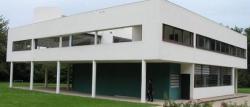
The machine age
The roots of the Modern Movement can be traced back to the profound social and technological changes which characterised the end of the 19th century and the beginning of the twentieth.
Cities in the western world were expanding. This urbanisation called for a new approach to building- new technologies would have to be embraced, offering cheaper, more efficient means of satisfying a larger population and a growing number of industrial clients. In the United States, the cities of Chicago and New York had embraced tall metal-framed buildings in the second half of the 19th century.
Louis Sullivan, one of the most prominent members of the 'Chicago School' of architects, coined the phrase "form follows function", a mantra for Modernists ever since. Sullivan and his contemporaries built astounding new skyscrapers, which would soon be a feature of cities across the world.
But although these skyscrapers were modern, they were not modernist (Le Corbusier criticised the Americans' lack of urban planning). The response of European architects to the Americans' technological advances (including bridges and other building forms as well as skyscrapers) would lead to the development of Modernism.
And in the early twentieth century, technological advances were rapidly changing western society. Road and rail networks were altering the face of modern countries, people were more mobile, goods and materials could be transported across the world easily and quickly. Reinforced concrete (a strong and efficient material pioneered by Auguste Perret); this and the availability of plate glass, meant that architects would soon be able to celebrate this new technology in the buildings they were designing.
Machines, in the form of cars, telephones, and ocean liners captured the public imagination, and emphasised the positive force that technology could play in people's lives. In 1921, Le Corbusier described a house as "a machine for living in". Le Corbusier and others believed that houses should have the purity of form of a well-designed machine. The formal qualities of mass-produced cars and other machines were therefore of great interest to them.
The shock of the new
Elsewhere in Europe, the short-lived De Stijl movement (1917-1931), a collection of Dutch artists and architects, wanted to liberate the arts from the shackles of tradition. Other movements such as Art Nouveau (1893-1914) and Expressionism (1912-1923) also experimented with bold, new forms and ideas, and in Russia the Constructivists (1920-1932) emphasised honesty of materials and functional simplicity in their (mostly public) buildings.
These movements appealed to many architects in Europe who felt that their profession had become trapped in the past. They believed that the new machine age demanded a new architecture.
In 1919, Walter Gropius founded the Bauhaus School in Weimar, Germany. This academy of architecture and design, although only in existence for fourteen years, established a tremendous reputation amongst the avant garde for its creative approach to architecture and design, a reputation that lives on to this day. Gropius' aims, as refined in 1923, in his text Idee und Aufbau, included the idea that workers in all the crafts should design for a better world using the idea of machine production as a stimulus.
New thinking on minimalist design and creating space was pioneered by Gropius' fellow German Ludwig Mies Van Der Rohe, who famously declared "less is more", and put his dictum into practice with his seminal Barcelona Pavilion in 1929.
Imagining a new world
One year prior to Barcelona, with the nascent Movement determined to win over a doubting public and architectural establishment, the Congres Internationaux d'Architecture Moderne (CIAM) had met for the first time. An immensely influential think-tank, CIAM sought to formalise the various roots of Modernism into a coherent set of rules. Its opening declaration called for architecture to be rationalised and standardised, and to be seen in context of economic and political realities.
In the years that followed, CIAM produced many radical and ambitious documents which sought to place architecture at the centre of economic and political discussions about building a new and better world.
And with the backing of CIAM, the Modernists began their mission to make architecture not simply about the building of buildings, but rather about the construction of a new way of living.
Rate and Review
Rate this article
Review this article
Log into OpenLearn to leave reviews and join in the conversation.
Article reviews